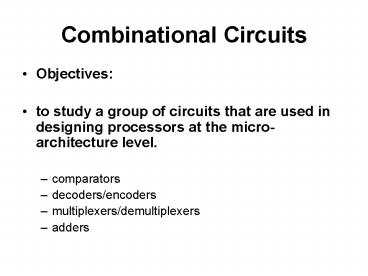Combinational Circuits - PowerPoint PPT Presentation
1 / 15
Title:
Combinational Circuits
Description:
decoders/encoders. multiplexers/demultiplexers. adders. Comparators ... An encoder is intended to identify a single active input signal. ... – PowerPoint PPT presentation
Number of Views:88
Avg rating:3.0/5.0
Title: Combinational Circuits
1
Combinational Circuits
- Objectives
- to study a group of circuits that are used in
designing processors at the micro-architecture
level. - comparators
- decoders/encoders
- multiplexers/demultiplexers
- adders
2
Comparators
- The basic function of a comparator is to compare
the magnitude of two binary quantities to
determine the relationship of those quantities.
3
A 1-bit comparator
- Let A B be the inputs and X be the output.
- 1-bit comparator is defined as X 1 if AB.
- X AB AB
4
Decoders
- A k-line-to-nline decoder has k input lines and
n 2k output lines - Its behavior is defined by the property that when
X denotes the binary number i, the corresponding
line zi with index (subscript) i is active and
all other lines inactive. - There is also usually a control line EN, called
the enable line, which must be active (EN 1)
for the decoder to operate when EN 0, all the
output lines are inactive
5
A 3-bit decoder or a 3-line-to-8-line decoder
(k3, n23)
- Simple decoder design
6
3-line-to-8-line decoder
- Simple decoder design
- D0 active ( 1) only when x y z 0 , so D0
x'y'z' - D1 x'y'z
- ..
- Di minterm of (x,y,z), with x MSB and z LSB
- As conclusion, we can say that the decoder
outputs for an active-HIGH(1) decoder are simply
minterms.
7
Encoders
- An encoder is the inverse of a decoder
- Typically has n 2k input lines and k output
lines. - An encoder is intended to identify a single
active input signal. However there is nothing to
prevent several of its input lines from being
active at the same time. - To deal with this situation, most encoders are
designed as priority encoders, which have the
property that when several inputs are active at
the same time, the output number i that appears
on Z is the index of the input line xi with the
highest priority.
8
Multiplexers
- a 2-to-1 multiplexer.
9
Multiplexers
- The main function of a multiplexer M (data
selector) is to control the transfer of data
words from one of several sources to a common
destination. - It has normally n 2k input data buses
connecting it to the destination D - A k-bit input address or "select" bus A
determines the source to connect through M to D - A multiplexer with n input data buses, each of
width m, is called an n-way, m-bit multiplexer.
10
Multiplexers
- A multiplexer that has n data inputs, w0,..,
wn-1 requires log2n) select inputs. - Larger multiplexer can also be constructed from
smaller multiplexers
11
4-to-1 built using three 2-to-1 multiplexers
12
4-1 multiplexer using 2-1 multiplexers
13
Multiplexers
- A general-purpose component to implement
combinational logic functions. - Example of a exclusive or gate
14
Multiplexers
- Exclusive or gate
15
De-multiplexers
- A demultiplexer basically reverses the
multiplexing function. It takes data from one
line and distributes them to given number of
output lines. A demultiplexer has N 2k output
lines, k address selection and one data line. The
number of the output line active is specified by
the k bits address.






























